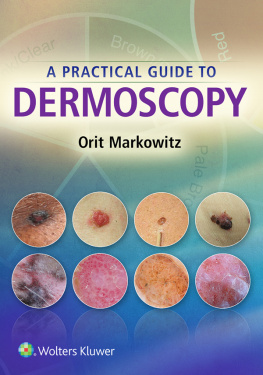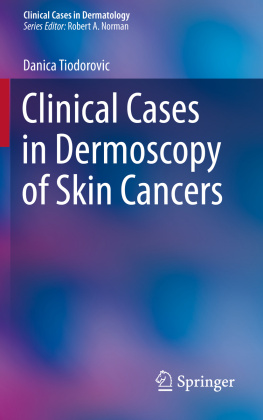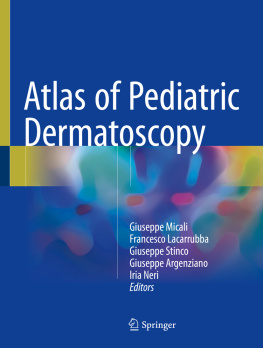A PRACTICAL GUIDE TO DERMOSCOPY
Orit Markowitz, MD, FAAD
Director of Pigmented Lesions and Skin Cancer
Associate Professor of Dermatology
Mount Sinai Medical Center
New York, New York
Director of Pigmented Lesions Clinic
Brooklyn VA
Brooklyn, New York
Adjunct Professor, Dermatology
SUNY Downstate Medical Center
Brooklyn, New York
Chief of Dermatology
Queens General Hospital
Jamaica, New York

Executive Editor: Rebecca Gaertner
Senior Development Editor: Kristina Oberle
Senior Production Project Manager: Alicia Jackson
Design Coordinator: Teresa Mallon
Senior Manufacturing Coordinator: Beth Welsh
Prepress Vendor: SPi Global
Copyright 2017 by Wolters Kluwer
All rights reserved. This book is protected by copyright. No part of this book may be reproduced or transmitted in any form or by any means, including as photocopies or scanned-in or other electronic copies, or utilized by any information storage and retrieval system without written permission from the copyright owner, except for brief quotations embodied in critical articles and reviews. Materials appearing in this book prepared by individuals as part of their official duties as U.S. government employees are not covered by the above-mentioned copyright. To request permission, please contact Wolters Kluwer at Two Commerce Square, 2001 Market Street, Philadelphia, PA 19103, via email at (products and services).
9 8 7 6 5 4 3 2 1
Printed in China
Library of Congress Cataloging-in-Publication Data
Names: Markowitz, Orit, author.
Title: A practical guide to dermoscopy / Orit Markowitz.
Description: Philadelphia : Wolters Kluwer, [2017] | Includes bibliographical references.
Identifiers: LCCN 2017003523 | ISBN 9781451192636
Subjects: | MESH: Dermoscopy | Skin Neoplasmsdiagnosis | Melanomadiagnosis | Nevusdiagnosis | Pigmentation Disorderspathology | Skin Pigmentation
Classification: LCC RC280.S5 | NLM WR 141 | DDC 616.99/477075dc23 LC record available at https://lccn.loc.gov/2017003523
This work is provided as is, and the publisher disclaims any and all warranties, express or implied, including any warranties as to accuracy, comprehensiveness, or currency of the content of this work.
This work is no substitute for individual patient assessment based upon healthcare professionals examination of each patient and consideration of, among other things, age, weight, gender, current or prior medical conditions, medication history, laboratory data and other factors unique to the patient. The publisher does not provide medical advice or guidance and this work is merely a reference tool. Healthcare professionals, and not the publisher, are solely responsible for the use of this work including all medical judgments and for any resulting diagnosis and treatments.
Given continuous, rapid advances in medical science and health information, independent professional verification of medical diagnoses, indications, appropriate pharmaceutical selections and dosages, and treatment options should be made and healthcare professionals should consult a variety of sources. When prescribing medication, healthcare professionals are advised to consult the product information sheet (the manufacturers package insert) accompanying each drug to verify, among other things, conditions of use, warnings and side effects and identify any changes in dosage schedule or contraindications, particularly if the medication to be administered is new, infrequently used or has a narrow therapeutic range. To the maximum extent permitted under applicable law, no responsibility is assumed by the publisher for any injury and/or damage to persons or property, as a matter of products liability, negligence law or otherwise, or from any reference to or use by any person of this work.
LWW.com
This book is for my father, Michael Markowitz. As an electronic engineer and inventor, his passion for science and discovery was truly infectious. His loss fueled my own passion for research and innovation at an early age and continues to drive me all of these years later. Thank you Dad.
Contributor
Sarah Utz, BA
MD Candidate 2017
Icahn School of Medicine at Mount Sinai
New York, New York
Preface
Dermoscopy has changed the landscape of how we manage pigmented lesions. While the technology is not new, it continues to evolve, and the ways in which residents and physicians learn how to best use this modality is likewise evolving. Well-established methods for learning dermoscopy have focused primarily on pattern recognition, and while this method is a crucial piece toward mastering dermoscopy, this method alone may not work for everyone or for every lesion. During my own training, I was struck by how identifying the pattern algorithm of certain lesions was not possible, specifically for early lesions and particularly for early amelanotic melanomas. I was intrigued by how to diagnose these more effectively, especially given that amelanotic melanoma, while being the most rare, is the most deadly when picked up. As my career evolved and I began teaching students, residents, and fellows, I was pushed to strengthen and actualize the connection between the clinical and dermoscopic exams. I found the most apparent link to be color. Over time, I began to recognize that different colors and color combinations clinically, and then dermoscopically, would correlate with my diagnoses, in some instances bypassing pattern altogether. So I set out to develop my own method of color recognition to complement and streamline the traditional pattern recognition method. At first, I simply began using the Color Wheel in my own practice, but quickly incorporated it into my teaching roles. Now as the Director of Pigmented Lesions of the Department of Dermatology at the Icahn School of Medicine at Mount Sinai and Director of the Pigmented Lesions Clinic at the Brooklyn Veterans Hospital of Downstate University Medical Center, I teach it to the students, residents, and fellows, in addition to directing the Greater New York Dermoscopy course annually for residents in New York. Further, I have lectured nationally and internationally on the Color Wheels utility in the diagnosis of early malignancies.
This book is truly a labor of love many years in the making. It is my immense pleasure to present my method in a user-friendly manual that can be used by newcomers and experts in the field alike. The majority of pictures and examples are ones that I have collected over the years from my own patients. The figures have been developed in collaboration with a phenomenal graphic designer, Rene Moreno, in order to visually lead us through the book. We begin by presenting and reviewing the traditional methods of dermoscopy, as well as briefly introducing the concepts behind dermoscopy for our newcomers. For our seasoned veterans of dermoscopy, we hope that this guide will be a welcome complement to your already vast knowledge and that you may pick up some new pearls along the way.
I owe a great deal of debt to my mentors of dermoscopy, Dr. Alfred Kopf, Dr. Harold S. Rabinowitz, and Margaret Oliviero, FNP, BC, for their continual support and guidance. And to my mentors of dermatology, Dr. Daniel Siegel and Dr. Mark Lebwohl, who support my research and are fierce advocates for the noninvasive imaging work I do, which all begins with dermoscopy.












